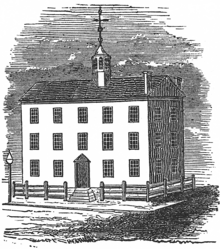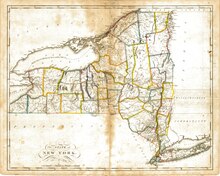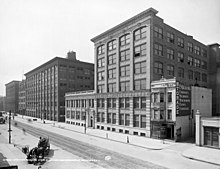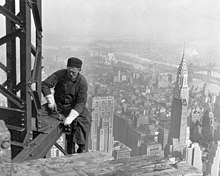History of New York (state)
New York hosted significant transportation advancements in the 19th century, including the first steamboat line in 1807, the Erie Canal in 1825, and America's first regularly scheduled rail service in 1831.
Due to New York City's trade ties to the South, there were numerous southern sympathizers in the early days of the American Civil War and the mayor proposed secession.
During the 19th century, New York City became the main entry point for European immigrants to the United States, beginning with a wave of Irish during their Great Famine.
The buildup of defense industries for World War II turned around the state's economy from the Great Depression, as hundreds of thousands worked to defeat the Axis powers.
Following a period of near-bankruptcy in the late 1970s, New York City renewed its stature as a cultural center, attracted more immigration, and hosted the development of new music styles.
[3] The five nations of the Iroquois League developed a powerful confederacy about the 15th century that controlled territory throughout present-day New York, into Pennsylvania around the Great Lakes.
[7] But, both groups of natives were well-established peoples with highly sophisticated cultural systems; these were little understood or appreciated by the European colonists who encountered them.
"[3] The Iroquois usually met at an Onondaga in Northern New York, which changed every century or so, where they would coordinate policies on how to deal with Europeans and strengthen the bond between the Five Nations.
He described "a vast coastline with a deep delta in which every kind of ship could pass" and he adds: "that it extends inland for a league and opens up to form a beautiful lake.
[10] In 1535, Jacques Cartier, a French explorer, became the first European to describe and map the Saint Lawrence River from the Atlantic Ocean, sailing as far upriver as the site of Montreal.
[11] On April 4, 1609, Henry Hudson, in the employ of the Dutch East India Company, departed Amsterdam in command of the ship Halve Maen (Half Moon).
[21] Even though New York City merchants lost out on lucrative military contracts, the group sought common ground between the King and the people; however, compromise became impossible as of April 1775 Battles of Lexington and Concord.
Had Gates not held, the rebellion might well have broken down: losing Saratoga would have cost the entire Hudson–Champlain corridor, which would have separated New England from the rest of the colonies and split the future union.
[26] In 1785, New York City became the national capital and continued as such on and off until 1790; George Washington was inaugurated as the first President of the United States in front of Federal Hall in 1789.
In 1841 Seward signed legislation to repeal a "nine-month law" that allowed slaveholders to bring their slaves into the state for a period of nine months before they were considered free.
Seward also signed legislation to establish public education for all children, leaving it up to local jurisdictions as to how that would be supplied (some had segregated schools).
The city's large Democrat community feared the impact of Abraham Lincoln's election in 1860 and the mayor urged secession of New York.
By the time of the 1861 Battle of Fort Sumter, such political differences decreased and the state quickly met Lincoln's request for soldiers and supplies.
Democratic Party leaders raised the specter of a deluge of freed southern blacks competing with the white working class, then dominated by ethnic Irish and immigrants.
On Monday, July 13, 1863, five days of large-scale riots began, which were dominated by ethnic Irish, who targeted blacks in the city, their neighborhoods, and known abolitionist sympathizers.
Starting with refugees from the Great Famine of Ireland in the 1840s, New York became a prominent entry point for those seeking a new life in the United States.
By the early 20th century, the statue, designed by sculptor Frédéric Auguste Bartholdi, was regarded as the "Mother of Exiles"—a symbol of hope to immigrants.
[47] The state was serviced by over a dozen major railroads and at the start of the 20th century and electric Interurban rail networks began to spring up around Syracuse, Rochester and other cities in New York during this period.
[48][49] In the late 1890s governor Theodore Roosevelt and fellow Republicans such as Charles Evans Hughes worked with many Democrats such as Al Smith to promote Progressivism.
Returning soldiers disproportionately displaced female and minority workers who had entered the industrial workforce only when the war left employers no other choice.
The project was unpopular with New York City Democrats, who referred to it as "Dewey's ditch" and the "enemy of schools", because the Thruway disproportionately benefited upstate.
He began as a liberal, but grew more conservative: he limited SUNY's growth, responded aggressively to the Attica Prison riot, and promulgated the uniquely severe Rockefeller Drug Laws.
Late–century Democrats became more centrist, including US Senator Daniel Patrick Moynihan (1977–2001) and New York City Mayor Ed Koch (1978–1989), while state Republicans began to align themselves with the more conservative national party.
[64]On October 29 and 30, 2012, Hurricane Sandy caused extensive destruction of the state's shorelines, ravaging portions of New York City, Long Island, and southern Westchester with record-high storm surge, with severe flooding and high winds causing power outages for hundreds of thousands of New Yorkers, and leading to gasoline shortages and disruption of mass transit systems.
The storm and its profound effects have prompted the discussion of constructing seawalls and other coastal barriers around the shorelines of New York City and Long Island to minimize the risk from another such future event.










